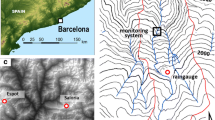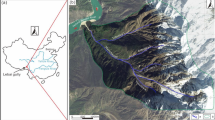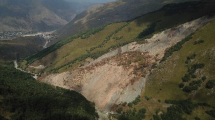Abstract
The Grand Canyon of the Nu River is the upper reach of the Salween River, and it is located on the eastern margin of the Tibetan Plateau. There were 187 debris flow gullies along the Grand Canyon of the Nu River, and debris flows from 53 of these gullies completely blocked the river. Debris flows have carried a large volume of sediment into the river since the Holocene and have formed high-density dams on the riverbed, with the maximum dam height exceeding 30 m. The Nu River comprises the repeated sections of straight flow connecting lakes and the debris flow dams that changed the movement and distribution of sediment in the river. In this paper, terrain data for debris flow dams were collected by Lidar, water depth data for the lakes were collected by an unmanned ship with a depth sounder, and the thicknesses of sediment deposits, both in the dams and in the lakes, were measured using a geophysical exploration method (EH4). The debris flow dams were stratified and had multi-stage stepped structures with high resistance because of repeated historical breaches of older dams and river coarsening, different from the structure of alluvial fans constructed by floods. The construction of debris flow dams and the sedimentation depths and volumes in the Grand Canyon were analyzed. The research shows that the high density of debris flow dams made the Grand Canyon stepped and the sedimentation rate greatly increased, reversing the Nu River Grand Canyon’s historical cutting trend.











Similar content being viewed by others
References
Birch SP, Hayes AG, Howard AD, Moore JM, Radebaugh J (2016) Alluvial fan morphology, distribution and formation on Titan. Icarus 270:238–247. https://doi.org/10.1016/j.icarus.2016.02.013
Burbank DW, Anderson RS (2001) Douglas W. Burbank and Robert S. Anderson: Tectonic Geomorphology. In: Tectonic geomorphology. Blackwell Science, Oxford Google Scholar, p 274. https://doi.org/10.1007/s10950-013-9376-1
Chen S, Wu C, Chao Y, Shih P (2013) Long-term impact of extra sediment on notches and incised meanders in the Hoshe River, Taiwan. J Mt Sci 10(5):716–723. https://doi.org/10.1007/s11629-013-2620-x
Goudie A (2004) Encyclopedia of geomorphology. Taylor Francis Group, Routledge Ltd, London, p 1156
Hack JT (1957) Studies of longitudinal stream-profiles in Virginia and Maryland: US geological survey professional paper 294B: 45–97
Hack JT (1973) Stream-profiles analysis and stream-gradient index. J Res US Geol Surv 1:421–429
Hanks TC, Webb RH (2006) Effects of tributary debris on the longitudinal profile of the Colorado River in Grand Canyon. J Geophys Res, 111(2). DOI: https://doi.org/10.1029/2004jf000257
Hewitt K (1998) Catastrophic landslides and their effects on the Upper Indus streams, Karakoram Himalaya, northern Pakistan. Geomorphology 26(1):47–80. https://doi.org/10.1016/S0169-555X(98)00051-8
Hewitt K (2002) Styles of rock-avalanche depositional complexes conditioned by very rugged terrain, Karakoram Himalaya, Pakistan. Rev Eng Geol: 345–377. DOI:https://doi.org/10.1130/REG15-p345
Hewitt K (2006) Disturbance regime landscapes: mountain drainage systems interrupted by large rockslides. Prog Phys Geogr 30(3):365–393. https://doi.org/10.1191/0309133306pp486ra
Hewitt K (2009) Catastrophic rock slope failures and late Quaternary developments in the Nanga Parbat–Haramosh Massif, Upper Indus basin, northern Pakistan. Quat Sci Rev 28(11):1055–1069. https://doi.org/10.1016/j.quascirev.2008.12.019
Korup O, Montgomery DR (2008) Tibetan plateau river incision inhibited by glacial stabilization of the Tsangpo gorge. Nature 455(7214):786–789. https://doi.org/10.1038/nature07322
Korup O, Montgomery DR, Hewitt K (2010) Glacier and landslide feedbacks to topographic relief in the Himalayan syntaxes. Proc Natl Acad Sci U S A 107(12):5317–5322. https://doi.org/10.1073/pnas.0907531107
Lancaster ST, Hayes SK, Grant GE (2003) Effects of wood on debris flow runout in small mountain watersheds. Water Resour Res 39(6). https://doi.org/10.1029/2001WR001227
Li X (2019) Risk assessment of debris flow based on negative feedback and residual energy of dam. Master Thesis, Tsinghua University, pp. 3–5. (in Chinese)
Lyu LQ (2017) Research on the initiation and motion of gully debris flows in Tibetan Plateau. Doctoral dissertation, Tsinghua University, Beijing, pp20 (In Chinese). http://cdmd.cnki.com.cn/Article/CDMD-10003-1018876137.htm
Matthias J, Oldrich H (2005) Debris-flow hazards and related phenomena. Springer, pp113
Ouimet WB, Whipple KX, Royden LH, Sun Z, Chen Z (2007) The influence of large landslides on river incision in a transient landscape: eastern margin of the Tibetan Plateau (Sichuan, China). Geol Soc Am Bull 119:1462–1476. https://doi.org/10.1130/B26136.1
Paliaga G, Faccini F, Luino F, Turconi L, Bobrowsky P (2019) Geomorphic processes and risk related to a large landslide dam in a highly urbanized Mediterranean catchment (Genova, Italy). Geomorphology: 48–61. DOI:https://doi.org/10.1016/j.geomorph.2018.10.020
Safran EB, Oconnor JE, Ely LL, House PK, Grant GE, Harrity K, Jones E (2015) Plugs or flood-makers? The unstable landslide dams of eastern Oregon. Geomorphology 248:237–251. https://doi.org/10.1016/j.geomorph.2015.06.040
Walsh LS, Martin AJ, Ojha TP (2012) Correlations of fluvial knick zones with landslide dams, lithologic contacts, and faults in the southwestern Annapurna Range, central Nepalese Himalaya. J Geophys Res 117:F01012
Wang ZY, Yu GA, Wang X, Melching CS, Liu L (2015) Sediment storage and morphology of the Yalu Tsangpo valley due to uneven uplift of the Himalaya. Sci China Earth Sci 58(8):1440–1445. https://doi.org/10.1007/s11430-015-5113-7
Whipple KX, Tucker GE (1999) Dynamics of the stream-power river incision model: implications for height limits of mountain ranges, landscape response times, and research needs. J Geophys Res 104(B8):17661–17676
Wobus CW, Crosby BT, Whipple KX (2006) Hanging valleys in fluvial systems: controls on occurrence and implications for landscape evolution. J Geophys Res Earth Surf 111(F2):2003–2012
Xu ZM (2011) Deposits of Zhaizicun landslide- dammed lake along Jinsha river and its implication for the genesis of Xigeda formation. Geol Rev 57(5):675–686 (in Chinese)
Mège D, Purcell P, Pochat S, Guidat T (2015) The Landscape and Landforms of the Ogaden, Southeast Ethiopia. In: Billi P. (eds) Landscapes and Landforms of Ethiopia. World Geomorphological Landscapes. Springer, Dordrecht: 429. https://doi.org/10.1007/978-94-017-8026-1_19
Acknowledgments
Thanks are due to Xinyue Liang from the Institute of Soil and Water Conservation, Chinese Academy of Sciences and Ministry of Water Resources, for her help in the field investigation.
Funding
This study is supported by the Chinese Academy of Sciences (XDA23090401), the National Natural Science Foundation of China (41790434, 41907229, and 31800610), the Fundamental Research Funds for the Central Universities (BLX201908), and the National Key R&D Program of China (2018YFC1505201). We also gratefully acknowledge the Beijing Municipal Education Commission for their financial support through the Innovative Transdisciplinary Program “Ecological Restoration Engineering.”
Author information
Authors and Affiliations
Corresponding authors
Rights and permissions
About this article
Cite this article
Lyu, L., Xu, M., Wang, Z. et al. Impact of densely distributed debris flow dams on river morphology of the Grand Canyon of the Nu River (upper Salween River) at the east margin of the Tibetan Plateau. Landslides 18, 979–991 (2021). https://doi.org/10.1007/s10346-020-01536-x
Received:
Accepted:
Published:
Issue Date:
DOI: https://doi.org/10.1007/s10346-020-01536-x




